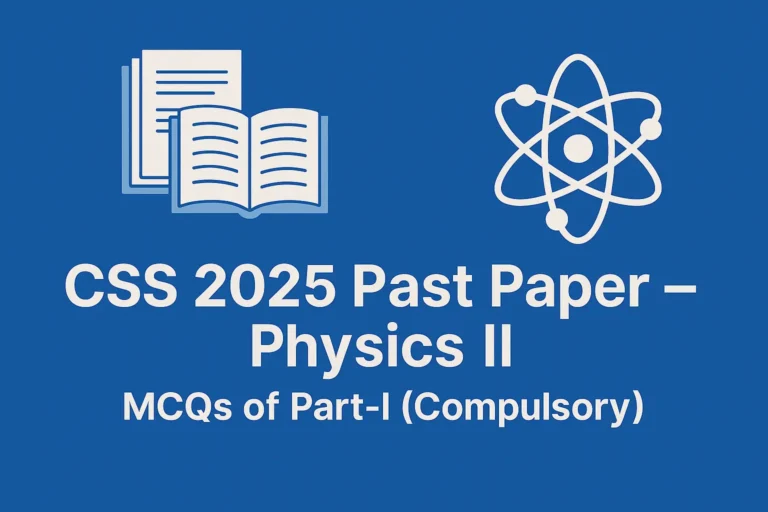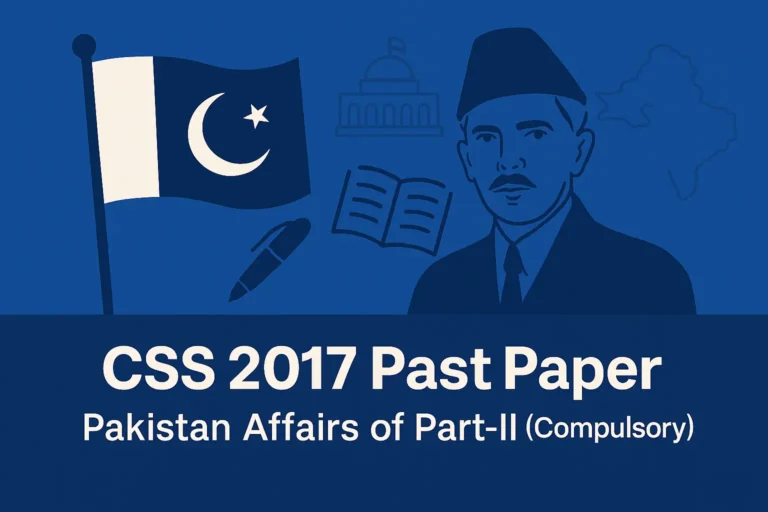CSS 2025 Solved Past Paper – General Science & Ability Part-II (Compulsory)
Below is the solution to PART-II (COMPULSORY) of the CSS 2025 General Science & Ability Paper.
Question 2
(a) What effects are produced due to Rotation & Revolution of Earth?
The Earth’s rotation on its axis and its revolution around the sun lead to significant environmental and astronomical effects.
Effects of Rotation:
- Day and Night Cycle: Rotation causes the alternation of day and night as different parts of Earth face or turn away from the Sun.
- Time Zones: Earth’s rotation divides the globe into longitudinal time zones.
- Apparent Motion of Sun: The sun appears to rise in the east and set in the west due to rotation.
- Coriolis Effect: Rotation deflects wind and ocean currents, influencing weather patterns.
Effects of Revolution:
- Seasons: The tilt of Earth’s axis combined with its revolution causes seasonal changes.
- Variation in Day Length: The duration of daylight changes throughout the year.
- Changing Altitude of the Sun: The sun appears higher or lower in the sky depending on Earth’s position in orbit.
- Leap Year: Earth’s revolution takes approximately 365.25 days, necessitating a leap year every four years.
(b) Describe Electromagnetic Radiations. Give its types and explain their applications.
Electromagnetic radiation (EMR) refers to waves of the electromagnetic field, propagating through space, carrying electromagnetic radiant energy. These waves travel at the speed of light and consist of oscillating electric and magnetic fields.
Types of Electromagnetic Radiations:
- Radio Waves – Used in radio, TV, and communication signals.
- Microwaves – Applied in cooking (microwave ovens), radar, and mobile communication.
- Infrared (IR) – Used in remote controls, thermal imaging, and night-vision devices.
- Visible Light – The only part of the spectrum visible to the human eye; used in lighting and optical instruments.
- Ultraviolet (UV) – Used in sterilization, medical therapy, and detecting forged currency.
- X-rays – Employed in medical imaging and security scanners.
- Gamma Rays – Used in cancer treatment and nuclear energy research.
Each type of EMR has a unique wavelength and energy level, defining its practical applications.
(c) What are Hurricanes? How are they formed and what level of damage can they produce?
Hurricanes are large, powerful tropical storms characterized by strong winds, torrential rain, and storm surges. In different parts of the world, they are also known as cyclones or typhoons.
Formation Process:
- Begins over warm ocean waters (above 26.5°C).
- Moist air rises, creating a low-pressure center.
- Continuous inflow of warm, moist air causes strong convection.
- Coriolis force helps in the spinning motion.
- As the system organizes, an eye forms at the center.
Damage Caused:
- Wind Destruction: Uproots trees, damages buildings, and power infrastructure.
- Flooding: Heavy rainfall leads to flash floods and landslides.
- Storm Surge: Causes coastal flooding by pushing seawater onto land.
- Economic Loss: Disrupts agriculture, transportation, and essential services.
Historically, hurricanes like Katrina (2005) and Haiyan (2013) have shown the immense devastation these systems can bring.
(d) Explain the advantages and disadvantages of nitrogen-containing fertilizers and insecticides.
Advantages:
Nitrogen Fertilizers:
- Boost crop yield by supplying essential nutrients.
- Enhance leaf and stem growth due to nitrogen’s role in protein synthesis.
- Improve food production efficiency to meet growing population needs.
Nitrogen-based Insecticides:
- Protect crops from pests and diseases.
- Increase crop survival rates and market value.
Disadvantages:
Nitrogen Fertilizers:
- Cause soil and water pollution through runoff (eutrophication).
- Lead to the release of nitrous oxide, a potent greenhouse gas.
- May reduce soil fertility over time due to acidification.
Nitrogen Insecticides:
- Harm beneficial insects (e.g., bees).
- Cause resistance in pests with prolonged use.
- Risk of bioaccumulation in food chains, affecting human and animal health.
Balanced use of fertilizers and integrated pest management can help mitigate these disadvantages while retaining agricultural benefits.
Question 3
(a) Explain how temperature and light intensity affect the rate of potosynthesis in plants.
Photosynthesis is a process by which green plants convert carbon dioxide and water into glucose using sunlight. Both temperature and light intensity significantly influence its rate.
Effect of Temperature:
- Photosynthesis is enzyme-dependent. Enzymes work best within an optimum range (25°C–35°C).
- At low temperatures, enzymatic activity slows down, reducing the photosynthesis rate.
- At very high temperatures, enzymes may denature, halting the process entirely.
Effect of Light Intensity:
- Light provides the energy for photosynthesis.
- As light intensity increases, the rate of photosynthesis also rises—up to a point.
- Beyond the saturation level, further increase in light doesn’t boost the rate due to other limiting factors like CO₂ or temperature.
In summary, both light and temperature must be within favorable ranges for optimal plant growth.
(b) Describe the structure and functions of capillaries in the human blood circulatory system.
Structure:
- Capillaries are the smallest and thinnest blood vessels in the circulatory system.
- They are composed of a single layer of endothelial cells.
- Their walls are semi-permeable to allow exchange of substances.
Functions:
- Exchange of Gases: Oxygen diffuses from blood to tissues, and carbon dioxide from tissues to blood.
- Nutrient Delivery: Glucose, amino acids, and other nutrients pass from blood into surrounding cells.
- Waste Removal: Metabolic wastes from cells move into capillaries for excretion.
- Thermoregulation: Blood flow through capillaries helps maintain body temperature.
Capillaries serve as vital exchange points between arteries and veins and are essential for cellular nourishment and homeostasis.
(c) What is hepatitis? Give its types and briefly explain its common symptoms along with preventions.
Hepatitis is the inflammation of the liver, typically caused by viral infections, but also by toxins, alcohol, or autoimmune diseases.
Types of Viral Hepatitis:
- Hepatitis A: Transmitted via contaminated food/water.
- Hepatitis B: Spread through blood, sexual contact, or from mother to child.
- Hepatitis C: Mostly transmitted through blood.
- Hepatitis D: Occurs only in presence of Hepatitis B.
- Hepatitis E: Similar to Hepatitis A; waterborne.
Common Symptoms:
- Fatigue
- Nausea and vomiting
- Abdominal pain (especially in upper right side)
- Jaundice (yellowing of skin and eyes)
- Dark urine and pale stools
Prevention Measures:
- Get vaccinated (for Hepatitis A and B).
- Avoid sharing needles and razors.
- Practice safe sex.
- Use clean drinking water and maintain food hygiene.
- Screen blood before transfusion.
Timely diagnosis and lifestyle care can help in managing and preventing hepatitis effectively.
(d) Differentiate between biomass and biogas. Briefly explain various methods for obtaining energy from biomass.
Biomass is organic matter derived from plants or animals used as fuel.
Biogas is a gaseous fuel produced by the anaerobic decomposition of biomass.
| Feature | Biomass | Biogas |
|---|---|---|
| Form | Solid or semi-solid | Gaseous (mainly CH₄, CO₂) |
| Source | Wood, crop waste, dung, etc. | Anaerobic digestion of biomass |
| Use | Burned directly for heat | Used for heating and electricity generation |
Methods for Energy from Biomass:
- Direct Combustion: Burning wood or crop residue to produce heat or electricity.
- Gasification: Converts biomass into combustible gas (syngas) using limited oxygen.
- Anaerobic Digestion: Microbial breakdown of waste in oxygen-free conditions to produce biogas.
- Fermentation: Converts biomass (e.g. sugarcane) into ethanol or other biofuels.
Biomass energy is renewable, but its sustainability depends on how responsibly it’s managed.
Question 4
(a) What is deforestation? State the disadvantages caused to the environment due to this.
Deforestation refers to the large-scale removal or clearing of forests, often to make way for agricultural activities, urban development, or logging.
Disadvantages of Deforestation:
- Loss of Biodiversity: Destruction of forest habitats leads to extinction of many plant and animal species.
- Climate Change: Trees absorb carbon dioxide; cutting them increases greenhouse gases and contributes to global warming.
- Soil Erosion: Trees anchor the soil; without them, topsoil is washed away by rain, leading to barren lands.
- Disturbed Rainfall Patterns: Forests influence the water cycle. Their removal can reduce rainfall and lead to droughts.
- Increased Natural Disasters: Landslides and floods become more frequent in deforested areas due to reduced natural barriers.
In short, deforestation threatens environmental balance, affecting all life forms on Earth.
(b) Explain how water pollution is produced? Describe the part played by bacteria after a river has been polluted by sewage
Water pollution occurs when harmful substances—like industrial waste, sewage, pesticides, and chemicals—enter water bodies, degrading their quality and making them unsafe for life.
Causes of Water Pollution:
- Industrial discharge
- Agricultural runoff (pesticides and fertilizers)
- Domestic sewage
- Oil spills and plastic waste
Role of Bacteria in Sewage-Polluted Rivers:
Once sewage enters a river, aerobic bacteria start breaking down organic matter. In doing so, they consume large amounts of dissolved oxygen (DO) in the water. This leads to:
- Decreased oxygen levels, suffocating aquatic life.
- Growth of anaerobic bacteria, which produce foul-smelling gases like methane and hydrogen sulfide.
- Water becomes unfit for human use and aquatic biodiversity suffers.
Thus, while bacteria help decompose waste, excessive pollution overwhelms the ecosystem.
(c) State some examples of pollution caused by human activity and discuss the effects of each example.
Here are common pollution types directly linked to human activity:
- Industrial Waste Dumping (Water Pollution):
- Factories discharge chemicals into rivers, harming aquatic life and contaminating drinking water.
- Vehicular Emissions (Air Pollution):
- Cars emit carbon monoxide and nitrogen oxides, leading to smog and respiratory diseases.
- Agricultural Chemicals (Soil and Water Pollution):
- Pesticides and fertilizers seep into the ground and water bodies, affecting crops and aquatic organisms.
- Plastic Waste (Land and Marine Pollution):
- Non-biodegradable plastics litter landscapes and oceans, posing threats to animals and blocking drainage systems.
- Noise from Construction and Traffic (Noise Pollution):
- Continuous noise affects human mental health, causes stress, and disturbs wildlife behavior.
Each of these pollutions stems from human negligence and contributes to environmental degradation and public health issues.
(d) What does air pollution mean? State ten serious effects of air pollution on the environment and briefly explain how they can be reduced.
Air pollution is the presence of harmful substances in the atmosphere, resulting from natural or human-made sources like vehicles, factories, and burning of fossil fuels.
Ten Serious Effects of Air Pollution:
- Global Warming: Greenhouse gases like CO₂ trap heat, raising Earth’s temperature.
- Acid Rain: Sulfur and nitrogen oxides mix with rainwater, damaging soil, plants, and buildings.
- Ozone Layer Depletion: CFCs break down ozone, increasing UV radiation reaching Earth.
- Respiratory Diseases: Polluted air causes asthma, bronchitis, and lung cancer.
- Cardiovascular Issues: Long-term exposure affects heart health and blood pressure.
- Reduced Crop Yield: Pollutants hinder plant growth and productivity.
- Animal Mortality: Air toxins harm wildlife, particularly birds and aquatic species.
- Smog Formation: Mix of smoke and fog reduces visibility and worsens breathing problems.
- Climate Disruption: Air pollution changes rainfall patterns and increases natural disasters.
- Reduced Quality of Life: Affects mental health, productivity, and overall well-being.
How to Reduce Air Pollution:
- Promote public transport and electric vehicles.
- Shift to renewable energy sources (solar, wind).
- Enforce stricter emission standards for industries.
- Ban burning of crop residues and garbage.
- Increase urban green spaces and tree plantation.
Sustainable practices and environmental awareness are key to combating air pollution.
Question 5
(a) Differentiate between food contaminants and food adulterants.
Though both relate to food safety, food contaminants and food adulterants are different in source and intent.
| Aspect | Food Contaminants | Food Adulterants |
|---|---|---|
| Definition | Unintended substances in food | Deliberately added inferior substances |
| Source | Industrial pollution, packaging, pesticides | Human malpractice, economic gain |
| Examples | Lead in water, pesticides on vegetables | Water in milk, brick powder in chili powder |
| Effect on Health | Can cause poisoning, cancer, or neurological damage | May cause allergies, organ damage, or disease |
In short, contaminants are accidental, while adulterants are intentional and often criminal in nature.
(b) Enlist major food groups based on nutrients, their functions and sources.
Food is categorized into groups based on the nutrients they primarily provide:
- Carbohydrates
- Function: Provide energy
- Sources: Bread, rice, wheat, potatoes
- Proteins
- Function: Body building, repair of tissues
- Sources: Eggs, fish, pulses, meat, dairy
- Fats
- Function: Energy storage, insulation
- Sources: Butter, oils, ghee, nuts
- Vitamins
- Function: Regulate body processes and boost immunity
- Sources: Fruits, vegetables, milk, fish
- Minerals
- Function: Strengthen bones, blood production, nerve functions
- Sources: Green leafy vegetables, salt, fruits, seafood
- Water
- Function: Maintains temperature, aids digestion, removes waste
- Sources: Drinking water, juices, fruits
- Fiber
- Function: Aids digestion and prevents constipation
- Sources: Whole grains, vegetables, fruits, legumes
A balanced diet includes all these groups in appropriate proportions.
(c) What is Artificial Intelligence and how does it differ from traditional programming? Describe the main branches of Artificial Intelligence.
Artificial Intelligence (AI) refers to the ability of machines to mimic human intelligence and perform tasks such as reasoning, learning, decision-making, and problem-solving.
Difference from Traditional Programming:
| Traditional Programming | Artificial Intelligence |
|---|---|
| Predefined instructions | Learns from data and adapts |
| No self-learning capability | Improves with experience (machine learning) |
| Fixed logic | Uses fuzzy logic, probabilistic reasoning |
| Example: Calculator | Example: Face recognition app |
Main Branches of AI:
- Machine Learning (ML):
- Enables systems to learn from data and make predictions.
- Example: Email spam filters.
- Natural Language Processing (NLP):
- Deals with understanding and generating human language.
- Example: Chatbots, voice assistants.
- Computer Vision:
- Enables machines to understand visual inputs like images or videos.
- Example: Facial recognition, self-driving cars.
- Robotics:
- AI applied to control and automate robots.
- Example: Assembly-line robots.
- Expert Systems:
- Mimic decision-making ability of a human expert.
- Example: Medical diagnosis systems.
AI is revolutionizing industries by enabling machines to perform tasks that once required human intelligence.
(d) What are the advantages of optical fibers in communication systems? Draw basic structure of optical fiber and explain propagation of light through it.
Advantages of Optical Fibers:
- High Bandwidth: Can carry large amounts of data.
- Speed: Light travels faster, ensuring rapid transmission.
- Low Signal Loss: Less attenuation compared to copper wires.
- Immunity to Electromagnetic Interference: Ideal for use in high-voltage areas.
- Security: Difficult to tap, offering better data protection.
- Lightweight and Durable: Easier to install and maintain.
Structure of Optical Fiber:
- Core: Central glass region through which light travels.
- Cladding: Surrounds the core and reflects light back inside via total internal reflection.
- Buffer Coating: Protective outer layer for mechanical strength.
[Buffer Coating]
↓
[Cladding]
↓
[Core] → Light Signal
Propagation of Light:
- Light enters at a specific angle.
- Due to the refractive index difference between the core and cladding, total internal reflection keeps the light bouncing within the core.
- This allows light to travel long distances with minimal loss.
Question 6
(a) In an annual sale, Saima buys a Fridge and a Freezer. The sale offers 15% off everything and she pays a total of Rs. 57,120. If the price of the freezer before the sale is Rs. 40,000, what was the price of the fridge before the sale
Let the original price of the fridge be x.
Discounted price of freezer:
15% of 40,000 = 0.15 × 40,000 = Rs. 6,000
So, discounted freezer price = 40,000 – 6,000 = Rs. 34,000
Discounted price of fridge:
= x – (15% of x) = x – 0.15x = 0.85x
Now, total payment = 0.85x + 34,000 = 57,120
Solving:
0.85x = 57,120 – 34,000 = 23,120
x = 23,120 / 0.85 = Rs. 27,200
Fridge’s original price = Rs. 27,200
(b) Mr. Rasheed pays a deposit of Rs. 60,000/- followed by 36 equal monthly payments. The total amount he pays is 127% of the basic price Rs. 3,360,000/-. Calculate Rasheed’s monthly payment.
Total price paid:
= 127% of 3,360,000
= (127/100) × 3,360,000 = Rs. 4,267,200
Remaining after deposit:
= 4,267,200 – 60,000 = Rs. 4,207,200
Monthly payment:
= 4,207,200 / 36 = Rs. 116,866.67
Monthly installment = Rs. 116,866.67
(c) Divide Rs. 600 among A, B and C so that Rs. 40 more than 2/5 of A’s share, Rs. 20 more than 2/7 of B’s share, and Rs. 10 more than 9/17 of C’s share are all equal.
Let:
- A’s share = a
- B’s share = b
- C’s share = c
We are given:
- (2/5)a + 40 = (2/7)b + 20 = (9/17)c + 10 = x (say)
So:
- (2/5)a = x – 40 ⇒ a = (5/2)(x – 40)
- (2/7)b = x – 20 ⇒ b = (7/2)(x – 20)
- (9/17)c = x – 10 ⇒ c = (17/9)(x – 10)
Now, total sum:
a + b + c = 600
Substitute values:
(5/2)(x – 40) + (7/2)(x – 20) + (17/9)(x – 10) = 600
Take LCM of 2, 2, 9 = 18
Convert all to denominator 18:
(5/2)(x – 40) = (45/18)(x – 40)
(7/2)(x – 20) = (63/18)(x – 20)
(17/9)(x – 10) = (34/18)(x – 10)
Add all:
(45(x – 40) + 63(x – 20) + 34(x – 10)) / 18 = 600
⇒ [45x – 1800 + 63x – 1260 + 34x – 340] / 18 = 600
⇒ (142x – 3400)/18 = 600
Multiply both sides by 18:
142x – 3400 = 10,800
142x = 14,200
x = 100
Now plug back:
a = (5/2)(100 – 40) = (5/2)(60) = Rs. 150
b = (7/2)(100 – 20) = (7/2)(80) = Rs. 280
c = (17/9)(100 – 10) = (17/9)(90) = Rs. 170
A = Rs. 150, B = Rs. 280, C = Rs. 170
(d) Find out the correct words from the jumbled spellings given below.
(i) TEANAIRM → Marinate
(ii) VAGNACEXETRA → Extravagance
(iii) VADIELTIONC → Vindication
(iv) PKUNYBARTC → Bankruptcy
(v) TAESROSNC → Castrones (Seems incorrect – likely intended to be “Contrastes” or “Constraes” but best fit is → Castrones seems like a miss)
Corrected words:
- Marinate
- Extravagance
- Vindication
- Bankruptcy
- Castrones (tentative)
Question 7
(a) Calculate the marked price of the sculpture if it is sold for Rs. 79,950/- after a discount of 18%. On another day, if 10% discount is given on the marked price before a further discount of 8%, would the sale price still be Rs. 79,950?
Let the marked price = x
First scenario (18% single discount):
Selling Price = x – (18% of x) = 0.82x
Given: 0.82x = 79,950
⇒ x = 79,950 ÷ 0.82 = Rs. 97,500
Marked Price = Rs. 97,500
Second scenario (successive 10% and 8% discounts):
10% off on Rs. 97,500:
= 0.90 × 97,500 = Rs. 87,750
Now 8% off on Rs. 87,750:
= 0.92 × 87,750 = Rs. 80,730
Rs. 80,730 ≠ Rs. 79,950
So, the sale price is not the same in the second scenario.
Answer: No, the final price is Rs. 80,730, which is different from Rs. 79,950.
(b) Majid pays a total of Rs. 51,520 for his car insurance. The total is made up of a basic charge plus 15% sales tax. Calculate the amount of sales tax that Majid pays.
Let basic charge = x
Sales tax = 15% of x = 0.15x
So, total = x + 0.15x = 1.15x = 51,520
x = 51,520 ÷ 1.15 = Rs. 44,800
Sales tax = 15% of 44,800 = 0.15 × 44,800 = Rs. 6,720
Sales tax paid = Rs. 6,720
(c) A campsite in the shape of a rectangle has sides (3x + 6) m and (x + 1) m, and the diagonal is (4x + 1) m. Find the area and the perimeter of the campsite.
Given:
Length = 3x + 6
Width = x + 1
Diagonal = 4x + 1
Use Pythagoras Theorem:
(3x + 6)² + (x + 1)² = (4x + 1)²
Expand all:
(9x² + 36x + 36) + (x² + 2x + 1) = 16x² + 8x + 1
⇒ 10x² + 38x + 37 = 16x² + 8x + 1
Bring all terms to one side:
10x² + 38x + 37 – 16x² – 8x – 1 = 0
⇒ -6x² + 30x + 36 = 0
⇒ Divide by -6: x² – 5x – 6 = 0
Solve:
x² – 5x – 6 = 0
⇒ (x – 6)(x + 1) = 0
⇒ x = 6 (Reject x = -1, as dimensions can’t be negative)
Now plug in x = 6:
Length = 3(6) + 6 = 24 m
Width = 6 + 1 = 7 m
Area = 24 × 7 = 168 m²
Perimeter = 2 × (24 + 7) = 2 × 31 = 62 m
(d) Arrange the following fractions in descending order.
We’ll convert each fraction to decimal for easy comparison:
(a)
- 7/12 = 0.583
- 4/7 = 0.571
- 9/14 = 0.643
- 25/42 = 0.595
Descending: 9/14 > 25/42 > 7/12 > 4/7
(b)
- 5/8 = 0.625
- 7/12 = 0.583
- 5/9 = 0.555
- 13/24 = 0.542
Descending: 5/8 > 7/12 > 5/9 > 13/24
(c)
- 6/35 = 0.171
- 5/21 = 0.238
- 2/7 = 0.285
- 4/15 = 0.266
Descending: 2/7 > 4/15 > 5/21 > 6/35
(d)
- 2/5 = 0.4
- 6/11 = 0.545
- 7/15 = 0.467
- 9/20 = 0.45
- 13/25 = 0.52
Descending: 6/11 > 13/25 > 7/15 > 9/20 > 2/5
(e)
- 1/5 = 0.2
- 2/7 = 0.285
- 3/8 = 0.375
- 4/13 = 0.307
- 5/17 = 0.294
Descending: 3/8 > 4/13 > 5/17 > 2/7 > 1/5
Question 8
(a) A train in first five successive minutes from its start runs 68m, 127m, 208m, 312m and 535m and for next 5 minutes maintains an average speed of 33 km/h. Find the whole distance covered and the average speed in covering this total distance.
First 5 minutes:
- Total distance = 68 + 127 + 208 + 312 + 535 = 1,250 meters
Next 5 minutes:
- Speed = 33 km/h = 33,000 meters/hour
Convert to m/min:
33,000 ÷ 60 = 550 m/min
Distance in next 5 minutes = 550 × 5 = 2,750 meters
Total distance covered:
1,250 + 2,750 = 4,000 meters
Total time = 10 minutes
Convert 10 minutes to hours = 10 ÷ 60 = 1/6 hour
Average speed = Total Distance ÷ Total Time
= 4,000 ÷ (1/6) = 4,000 × 6 = 24,000 m/h = 24 km/h
Total Distance = 4,000 m, Average Speed = 24 km/h
(b) A solid cuboid with base 10 cm × 6 cm has height ‘y’. Its total surface area is 376 cm². Find the height of the cuboid.
Surface Area of Cuboid:
= 2(lb + bh + hl)
= 2(10×6 + 6y + 10y)
= 2(60 + 16y)
= 120 + 32y
Given: 120 + 32y = 376
⇒ 32y = 376 – 120 = 256
⇒ y = 256 ÷ 32 = 8 cm
Height (y) = 8 cm
(c) In a six-member family (A, B, C, D, E, F), there are two fathers, three brothers, and a mother. If C is the sister of F, B is the brother of E’s husband. D is the father of A and grandfather of F. Who is E’s husband?
Let’s analyze:
- D is father of A → D is A’s father
- D is also grandfather of F → A must be father of F
⇒ A is son of D and father of F - C is sister of F → F and C are siblings (same parents)
⇒ A is father of both F and C - B is brother of E’s husband
⇒ A is E’s husband, so B is A’s brother - One mother must be E
So, family structure:
- D (Grandfather, father of A & B)
- A (Father, husband of E)
- B (Brother of A)
- E (Mother)
- C (Daughter of A & E)
- F (Son of A & E)
E’s husband = A
(d) How many prime numbers are between each of the following pairs of numbers?
We need to count prime numbers strictly between the square roots.
a) √3 and √120
√3 ≈ 1.73, √120 ≈ 10.95
So check primes between 2 and 10:
Primes = 2, 3, 5, 7 ⇒ Total = 4 primes
b) √102 and √4102
√102 ≈ 10.1, √4102 ≈ 64.0
Check primes between 11 and 63:
Primes = 11, 13, 17, 19, 23, 29, 31, 37, 41, 43, 47, 53, 59, 61
⇒ Total = 14 primes
c) √103 and √9993
√103 ≈ 10.1, √9993 ≈ 99.96
Check primes between 11 and 99:
Primes =
11, 13, 17, 19, 23, 29, 31, 37, 41, 43, 47, 53,
59, 61, 67, 71, 73, 79, 83, 89, 97
⇒ Total = 21 primes
d) √283 and √120
√283 ≈ 16.8, √120 ≈ 10.95
No number exists where lower bound > upper bound ⇒ 0 primes
e) √82 and √400
√82 ≈ 9.05, √400 ≈ 20
Primes between 10 and 19:
11, 13, 17, 19 ⇒ Total = 4 primes
Answers Summary:
- a) 4 primes
- b) 14 primes
- c) 21 primes
- d) 0 primes
- e) 4 primes






